- Clone
- 1H9 (See other available formats)
- Regulatory Status
- RUO
- Other Names
- Paired box 5, B-cell lineage specific activator, BSAP, paired box homeotic gene 5
- Isotype
- Rat IgG2a, κ
- Ave. Rating
- Submit a Review
- Product Citations
- publications
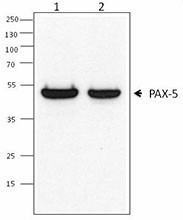
-

Western blot analysis of Daudi (lane 1) and A20 (lane 2) cells using anti-PAX-5 antibody (1H9). -

Ramos cells were fixed with 4% paraformaldehyde (PFA) for ten minutes, permeabilized with 0.5% Triton X-100 for five minutes, and blocked with 5% FBS for 30 minutes. Then the cells were intracellularly stained with 2 µg/mL anti-Pax-5 Antibody (clone 1H9) followed by Alexa Fluor® 594 (red) conjugated goat anti-rat IgG in blocking buffer for two hours at room temperature. Actin filaments were labeled with Alexa Fluor® 488 Phalloidin (green). Nuclei were counterstained with DAPI (blue). The image was captured with a 60X objective -

Tissue from human tonsil sections was fixed in 10% buffered formalin overnight, processed in paraffin and placed onto SuperfrostPlus slides. Prior to staining, slides were de‐waxed by incubation at 60°C for 30 minutes followed by three 2‐minute washes in xylene. Slides were hydrated in three 2‐minute washes in absolute alcohol then washed in water for 1 minute. An antigen retrieval step followed in which slides were placed in 10mM Citric Acid + 0.05% Tween 20 (pH 6) in a microwave set on high for 30 minutes. Slides were allowed to cool to RT then washed twice (5 minutes each) in 0.05M Tris, 0.15M NaCl and 0.05% Tween 20. Endogenous peroxidase in tissue samples was blocked by applying Peroxidase Block (DakoCytomation) to the slides for 5 minutes at RT, followed by an additional wash. The slides were incubated with primary antibody (Pax5 mAb, 1:50 dilution of 0.8 mg/ml stock) for 1 hour at RT. Slides were washed and incubated with anti‐rat IgG HRP at RT for 45 minutes (1 in 50 dilution). Slides were washed and then Diaminobenzidine Plus (DakoCytomation) was applied for 5‐10 minutes. Slides were washed in distilled H2O and then counterstained in haematoxylin for 15 seconds before mounting.
| Cat # | Size | Price | Quantity Check Availability | Save | ||
|---|---|---|---|---|---|---|
| 649702 | 100 µg | 265 CHF | ||||
Pax5, also known as BSAP (B cell specific activator protein), is a member of the paired box (Pax) family of transcription factors. PAX proteins are important regulators in early development, and alterations in the expression of their genes are thought to contribute to neoplastic transformation. Pax5 is the only member of the Pax family of transcription factors that is expressed in hematopoietic cells. During embryogenesis, Pax5 is transiently expressed in the brain of mice and in the mesencephalon and spinal cord of humans. Its expression is upregulated early in B cell development at the time of B cell commitment and is maintained throughout most subsequent stages. Suppression of Pax5 is essential for expression of Blimp-1 and the terminal differentiation of plasma cells. In the spleen, expression of Pax5 is higher in marginal zone B cells (B220+ CD21high CD23low) than in other B cells, especially the transition 1 stage (B220+ CD21- CD23-). In addition to its role in B cell development, Pax5 also affects VH-DJH heavy chain recombination as well as influencing the expression of many other B and non-B cell related proteins. Its expression has also been detected in developing CNS and testis and so the encoded protein may also play a role in neural development and spermatogenesis.
This gene is located at 9p13, which is involved in t(9;14)(p13;q32) translocations recurring in small lymphocytic lymphomas of the plasmacytoid subtype, and in derived large-cell lymphomas. This translocation brings the potent E-mu enhancer of the IgH gene into close proximity of the PAX5 promoter, suggesting that the deregulation of transcription of this gene contributes to the pathogenesis of these lymphomas. Alternatively spliced transcript variants encoding different isoforms have been described but their biological validity has not been determined.
Product Details
- Verified Reactivity
- Human, Mouse
- Antibody Type
- Monoclonal
- Host Species
- Rat
- Immunogen
- Recombinant mouse Pax-5 protein
- Formulation
- This antibody is provided in phosphate-buffered solution, pH 7.2, 0.09% NaN3.
- Preparation
- The antibody was purified by affinity chromatography.
- Concentration
- 0.5 mg/ml
- Storage & Handling
- Upon receipt, store undiluted between 2°C and 8°C
- Application
-
WB - Quality tested
ICC, IHC-P - Verified - Recommended Usage
-
Each lot of this antibody is quality control tested by Western blotting. For Western blotting, the suggested use of this reagent is 2.0 - 4.0 µg per ml. For immunocytochemistryon formalin-fixed paraffin-embedded tissue, a concentration range of 1.0 - 5.0 μg/ml is recommended. It is recommended that the reagent be titrated for optimal performance for each application.
- Application Notes
-
The monoclonal 1H9 antibody recognizes both mouse and human Pax5.
Additional reported applications (for the relevant formats) include: Western blotting1,2, immunohistochemical staining of formalin-fixed sections, and spatial biology (IBEX)4,5.NOTE: For flow cytometric staining with this clone, True-Nuclear™ Transcription Factor Buffer Set (Cat. No. 424401) offers improved staining and is highly recommended over the Foxp3 Fix/Perm Buffer Set (Cat. No. 421403) and the Nuclear Factor Fixation and Permeabilization Buffer Set (Cat. No. 422601).
-
Application References
(PubMed link indicates BioLegend citation) - Product Citations
-
- RRID
-
AB_10683169 (BioLegend Cat. No. 649702)
Antigen Details
- Structure
- 391 amino acids with predicted molecular weight of 42 kD
- Distribution
-
Nucleus
- Function
- Plays an important role in B-cell differentiation as well as neural development and spermatogenesis; involved in the regulation of the CD19 gene, a B-lymphoid-specific target gene
- Interaction
- Interacts with DAXX; binds DNA as a monomer, binds TLE4
- Cell Type
- B cells
- Biology Area
- Cell Biology, Immunology, Transcription Factors
- Molecular Family
- Nuclear Markers
- Antigen References
-
1. Liao F, et al. 1992. J. Immunol. 148:2909.
2. Nutt SL, et al. 1997. Genes Dev. 11:476.
3. Nera KP, et al. 2006. Immunity 24:283.
4. Fuxa M, et al. 2007. Immunity 178:3031. - Gene ID
- 5079 View all products for this Gene ID
- UniProt
- View information about Pax-5 on UniProt.org
Related Pages & Pathways
Pages
Related FAQs
Other Formats
View All Pax-5 Reagents Request Custom Conjugation| Description | Clone | Applications |
|---|---|---|
| Purified anti-Pax-5 | 1H9 | WB,ICC,IHC-P |
| Alexa Fluor® 647 anti-Pax-5 | 1H9 | ICFC,SB |
| Alexa Fluor® 488 anti-Pax-5 | 1H9 | ICFC |
| PE anti-Pax-5 | 1H9 | ICFC |
| PerCP/Cyanine5.5 anti-Pax-5 | 1H9 | ICFC |
| Alexa Fluor® 594 anti-Pax-5 | 1H9 | ICC |
| TotalSeq™-Bn1223 anti-Pax-5 | 1H9 | SB |
| TotalSeq™-B1223 anti-Pax-5 Antibody | 1H9 | ICPG |
Compare Data Across All Formats
This data display is provided for general comparisons between formats.
Your actual data may vary due to variations in samples, target cells, instruments and their settings, staining conditions, and other factors.
If you need assistance with selecting the best format contact our expert technical support team.
-
Purified anti-Pax-5
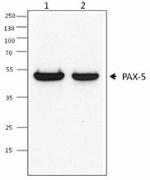
Western blot analysis of Daudi (lane 1) and A20 (lane 2) cel... 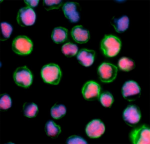
Ramos cells were fixed with 4% paraformaldehyde (PFA) for te... 
Tissue from human tonsil sections was fixed in 10% buffered ... -
Alexa Fluor® 647 anti-Pax-5
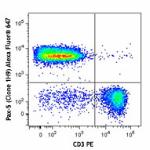
C57BL/6 mouse splenocytes were surface stained with mouse CD... 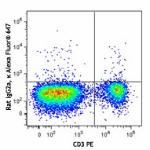
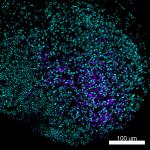
Mice were injected subcutaneously with sheep red blood cells... -
Alexa Fluor® 488 anti-Pax-5

C57BL/6 mouse splenocytes were surface stained with mouse CD... 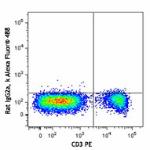
-
PE anti-Pax-5
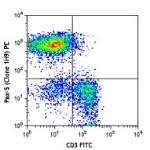
C57BL/6 mouse splenocytes were surface stained with mouse CD... 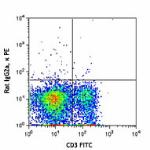
-
PerCP/Cyanine5.5 anti-Pax-5

C57BL/6 mouse splenocytes were stained with mouse CD3 APC th... -
Alexa Fluor® 594 anti-Pax-5

Daudi cells were fixed with 4% paraformaldehyde (PFA) for 10... -
TotalSeq™-Bn1223 anti-Pax-5
-
TotalSeq™-B1223 anti-Pax-5 Antibody

 Login / Register
Login / Register 







Follow Us